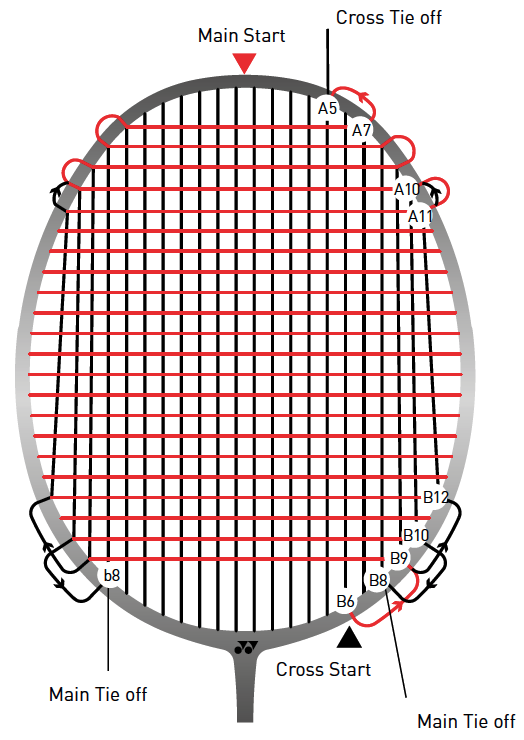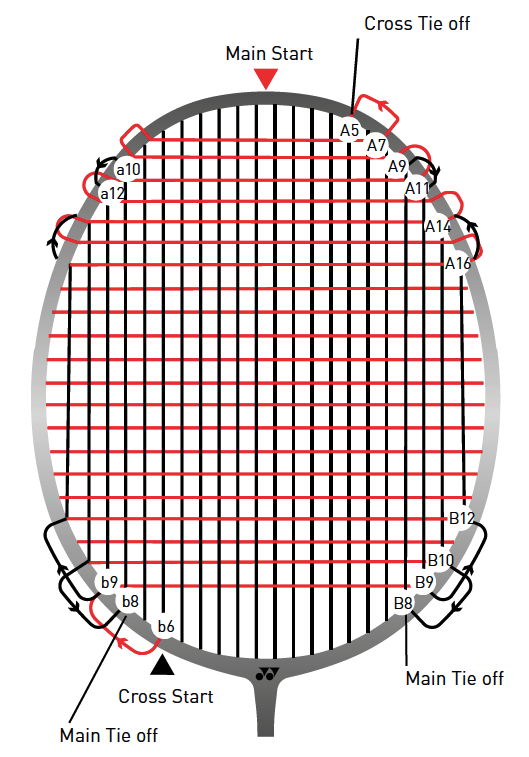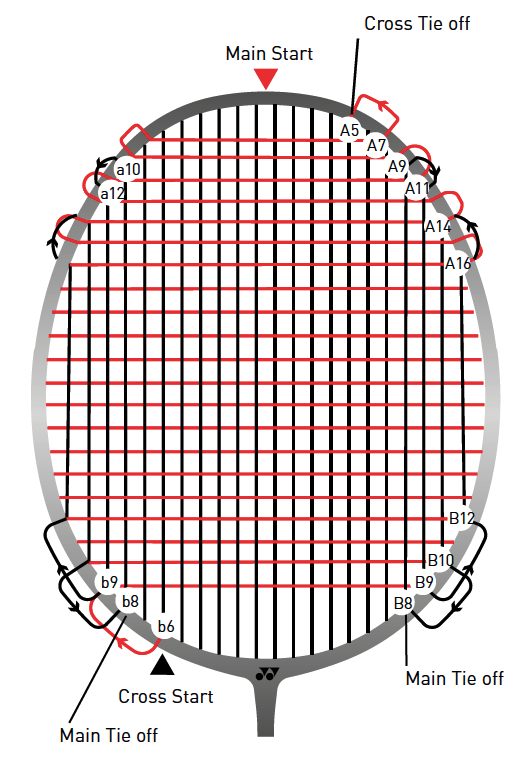Stringing a badminton racket can seem tricky at first. But with the right steps, anyone can do it.
Stringing a badminton racket is essential for maintaining good performance. Whether you’re a beginner or an experienced player, knowing how to string your racket can save you time and money. The process involves threading the string through the racket’s holes in a specific pattern.
This ensures the strings are tight and even, which improves your game. Properly strung rackets offer better control and power during play. In this guide, we’ll break down the stringing process into simple steps. You’ll learn what tools you need, how to start the stringing, and tips to make the job easier. Follow along, and you’ll have your racket ready for the court in no time.
Choosing The Right String
Choosing the right string for your badminton racket is essential. The string you choose affects your game’s performance. It can impact your control, power, and overall feel. Let’s explore the different aspects of choosing the right string.
Types Of Strings
Badminton strings come in various types. The most common are synthetic gut, multifilament, and natural gut.
Synthetic gut strings are durable and affordable. They are suitable for beginner players.
Multifilament strings offer better control and feel. They are made from many tiny fibers. Advanced players often prefer them.
Natural gut strings provide the best feel and power. They are made from natural materials. They are also the most expensive and less durable.
Gauge And Thickness
Gauge refers to the thickness of the string. It is measured in millimeters.
Thicker strings (lower gauge) are more durable. They are great for players who frequently break strings.
Thinner strings (higher gauge) offer more power and control. They provide better feel and spin.
Common gauges range from 0.65 mm to 0.75 mm. Choose the gauge that fits your play style.

Credit: www.youtube.com
Understanding String Tension
String tension is a crucial aspect of badminton racket stringing. It directly affects your control, power, and overall performance. This section will help you understand the ideal string tension and its impact on your game.
Ideal Tension Range
The ideal tension range for badminton rackets varies between players. Generally, 18 to 24 pounds is a suitable range. Beginners should aim for lower tension, while advanced players may prefer higher tension.
| Player Level | Tension Range (lbs) |
|---|---|
| Beginner | 18-20 |
| Intermediate | 20-22 |
| Advanced | 22-24 |
Choosing the right tension can improve your game. Below, let’s explore how string tension impacts your performance.
Impact On Performance
String tension affects both control and power. Lower tension provides more power. The shuttlecock can bounce off the strings with greater force. This is because the strings have more elasticity.
- Power: Lower tension (18-20 lbs) gives more power. Suited for beginners.
- Control: Higher tension (22-24 lbs) offers better control. Preferred by advanced players.
Higher tension offers better control. The shuttlecock stays on the strings longer, allowing precise placement. This is ideal for players focusing on accuracy.
Understand your game style. Choose a tension that enhances your strengths. Test different tensions to find your perfect fit.
Tools And Equipment Needed
Stringing a badminton racket requires the right tools and equipment. These tools ensure your racket is strung correctly and performs at its best. Having the proper tools can make the stringing process much easier. Let’s explore the essential tools and equipment needed to string a badminton racket.
Stringing Machine
A stringing machine is the most important tool you need. This machine holds the racket in place and helps you tension the strings correctly. There are two main types:
- Manual Stringing Machines: These require you to adjust the tension by hand.
- Electronic Stringing Machines: These automatically adjust the tension for you.
Both types have their pros and cons. Choose one that fits your budget and skill level.
Clamps And Awls
Clamps are essential for holding the strings in place. They prevent the strings from slipping while you work. There are two types of clamps:
- Flying Clamps: These are movable and can be used at any point on the string.
- Fixed Clamps: These are attached to the stringing machine and provide more stability.
An awl is a small, pointed tool. It helps you to guide the string through the tight spaces of the racket frame. This tool is very useful for making minor adjustments.

Credit: www.youtube.com
Preparing The Racket
Before stringing a badminton racket, proper preparation is crucial. This ensures better string tension and racket longevity. Follow these steps to get your racket ready for stringing.
Removing Old Strings
First, remove the old strings. Use a pair of scissors. Cut the strings in the center. This prevents any sudden tension release. Carefully pull out the cut strings. Make sure to remove all string pieces from the grommets.
Inspecting The Frame
Next, inspect the racket frame. Check for any cracks or damages. A damaged frame may break during stringing. Ensure the grommets are in good condition. Worn-out grommets can damage new strings. Replace any damaged grommets before proceeding.
Stringing Techniques
Stringing a badminton racket correctly can make a big difference in your game. Different stringing techniques can affect your play style. This section will explore the key stringing techniques to help you choose the best method.
One-piece Vs. Two-piece Stringing
One-piece stringing uses a single string to cover the entire racket. It is simpler and often quicker. This method is good for beginners. The tension is more even, but it can be less durable.
Two-piece stringing uses two separate strings. One for the mains and one for the crosses. This method allows for different tensions on each string. This can give you more control and power. It is often preferred by advanced players.
Weaving Patterns
Weaving patterns refer to how you cross the strings. The basic pattern is over and under. This creates a grid on the racket. Another pattern is the box weave. It offers better tension and durability.
Some players use the “around the world” pattern. This helps to maintain tension and balance. Choosing the right weaving pattern can improve your performance. Experiment with different patterns to see what works best for you.

Credit: www.badmintonbay.com
Step-by-step Stringing Process
Stringing a badminton racket may seem difficult, but it’s straightforward with the right steps. This guide will walk you through the process. You’ll learn how to mount the racket and tension the strings.
Mounting The Racket
First, secure the racket on the stringing machine. The racket must be stable. This prevents any movement during the stringing process. Follow these steps to mount your racket:
- Place the racket’s head in the machine’s holding clamps.
- Ensure the clamps grip the racket evenly.
- Adjust the side supports to hold the racket frame.
Double-check that the racket is secure. This prevents damage and ensures a smooth process.
Tensioning The Strings
Once the racket is mounted, you can start tensioning the strings. This step is crucial. Proper tension affects playability and durability. Follow these steps for tensioning:
- Thread the string through the top grommets.
- Pull the string to your desired tension using the machine.
- Clamp the string to hold the tension.
- Repeat for the main strings and cross strings.
Refer to your racket’s specifications for the correct tension range. Over-tensioning can break the racket or string.
Here’s a quick reference table for tension levels:
| Player Level | Tension Range (lbs) |
|---|---|
| Beginner | 18-20 |
| Intermediate | 20-23 |
| Advanced | 24-28 |
Remember to maintain even tension across all strings. This keeps your racket balanced.
Common Mistakes To Avoid
Stringing a badminton racket can be tricky. Many players make common mistakes. These mistakes can affect the racket’s performance and durability. Learn about these mistakes and avoid them.
Over-tightening
One common mistake is over-tightening the strings. Players often think tighter strings give more control. This is not always true. Over-tightening can damage the racket frame. It can also lead to string breakage.
Here is a table showing the recommended string tension for different skill levels:
| Skill Level | Recommended Tension (lbs) |
|---|---|
| Beginner | 18-20 |
| Intermediate | 20-24 |
| Advanced | 24-28 |
Stick to these ranges to keep your racket in good shape. Avoid the temptation to go beyond these values.
Skipping Crosses
Another mistake is skipping crosses. Cross strings are crucial for racket stability. Skipping them weakens the string bed. It also affects your shots.
Here is a simple checklist to ensure you do not skip crosses:
- Count the number of main strings.
- Ensure each main string has a cross string.
- Double-check your work after finishing.
Following this checklist can help you avoid skipping crosses. This will keep your racket strong and reliable.
Maintaining Your String Job
Maintaining your badminton racket’s string job is crucial. Regular checks and timely replacements can ensure optimal performance. Understanding how to care for your racket can prolong its life and improve your game.
Checking Tension Regularly
Check the tension of your racket strings often. Proper tension ensures better control and power. Press the strings with your thumb. They should feel firm, not loose. If they move too much, it’s time to adjust the tension. Consistent tension helps maintain your racket’s performance. You can use a tension tester for accuracy. Many sporting goods stores offer this tool.
Replacing Worn Strings
Worn strings affect your game. Inspect your racket for frayed or broken strings. Replace them immediately. Old strings can snap unexpectedly. This can ruin a match. Fresh strings provide better control and power. Regular replacements keep your racket in top shape. Most players replace strings every few months. Your frequency may vary based on use. Keep an eye on your strings’ condition.
Frequently Asked Questions
How Often Should I Restring My Badminton Racket?
It depends on your playing frequency. Casual players can restring every 6 months. Regular players should restring every 3 months for optimal performance.
What String Tension Is Best For Beginners?
Beginners should use a lower tension, around 18-20 lbs. This provides more power and reduces the risk of injury.
Can I String My Badminton Racket At Home?
Yes, you can string your racket at home. You need a stringing machine and some practice to get it right.
What Type Of Strings Should I Use?
Choose strings based on your playing style. Multifilament strings offer power and comfort. Monofilament strings provide control and durability.
Conclusion
Stringing a badminton racket is easier than you think. Just follow the steps. Gather the right tools. Use a stringing machine for precision. Follow the string pattern carefully. Double-check the tension settings. Practice makes perfect. Soon, you will string like a pro.
Enjoy playing with your newly strung racket. Your game will improve with a well-maintained racket. Keep practicing and have fun on the court.



